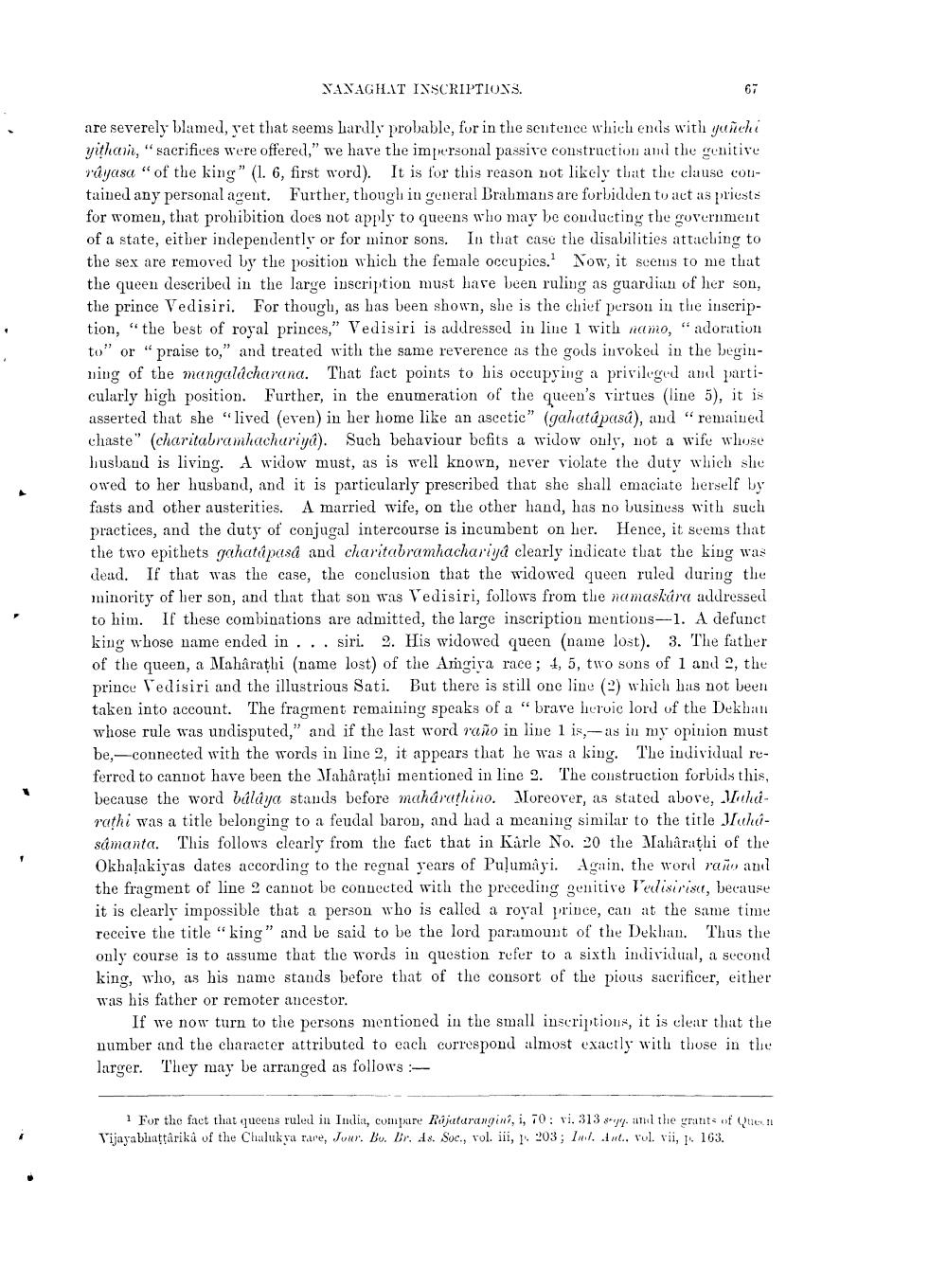________________
NANAGHAT INSCRIPTIONS.
67
are severely blamed, yet that seems hardly probable, for in the sentence which ends with guchi yitham," sacrifices were offered," we have the impersonal passive construction and the genitive rayasa" of the king" (1. 6, first word). It is for this reason not likely that the clause contained any personal agent. Further, though in general Brahmans are forbidden to act as priests for women, that prohibition does not apply to queens who may be conducting the government of a state, either independently or for minor sons. In that case the disabilities attaching to the sex are removed by the position which the female occupies. Now, it seems to me that the queen described in the large inscription must have been ruling as guardian of her son, the prince Vedisiri. For though, as has been shown, she is the chief person in the inscription, "the best of royal princes," Vedisiri is addressed in line 1 with namo, "adoration to" or "praise to," and treated with the same reverence as the gods invoked in the beginning of the mangalicharana. That fact points to bis occupying a privileged and parti cularly high position. Further, in the enumeration of the queen's virtues (line 5), it is asserted that she "lived (even) in her home like an ascetic" (gahatapasú), and "remained chaste" (charitabramhachariya). Such behaviour befits a widow only, not a wife whose husband is living. A widow must, as is well known, never violate the duty which she owed to her husband, and it is particularly prescribed that she shall emaciate herself by fasts and other austerities. A married wife, on the other hand, has no business with such practices, and the duty of conjugal intercourse is incumbent on her. Hence, it seems that the two epithets gahatápast and charitabramhachariya clearly indicate that the king was dead. If that was the case, the conclusion that the widowed queen ruled during the minority of her son, and that that son was Vedisiri, follows from the namaskara addressed to him. If these combinations are admitted, the large inscription mentions-1. A defunct king whose name ended in . . . siri. 2. His widowed queen (name lost). 3. The father of the queen, a Mahârathi (name lost) of the Amgiya race; 4, 5, two sons of 1 and 2, the prince Vedisiri and the illustrious Sati. But there is still one line (2) which has not been taken into account. The fragment remaining speaks of a "brave heroic lord of the Dekhan whose rule was undisputed," and if the last word raño in line 1 is, as in my opinion must be,-connected with the words in line 2, it appears that he was a king. The individual referred to cannot have been the Maharathi mentioned in line 2. The construction forbids this, because the word bâlâya stands before maharathino. Moreover, as stated above, Mahdrathi was a title belonging to a feudal baron, and had a meaning similar to the title Mahisamanta. This follows clearly from the fact that in Karle No. 20 the Maharathi of the Okhalakiyas dates according to the regnal years of Pulumâyi. Again, the word raño and the fragment of line 2 cannot be connected with the preceding genitive Vedisirisa, because it is clearly impossible that a person who is called a royal prince, can at the same time receive the title "king" and be said to be the lord paramount of the Dekhan. Thus the only course is to assume that the words in question refer to a sixth individual, a second king, who, as his name stands before that of the consort of the pious sacrificer, either was his father or remoter ancestor.
If we now turn to the persons mentioned in the small inscriptions, it is clear that the number and the character attributed to each correspond almost exactly with those in the larger. They may be arranged as follows:
1 For the fact that queens ruled in India, compare Rajatarangini, i, 70: vi. 313 sq. and the grants of Queen Vijayabhattarika of the Chalukya rare, Jour. Bo. Br. As. Soc., vol. iii, p. 203; Iul. Aut., vol. vii, p. 163.




